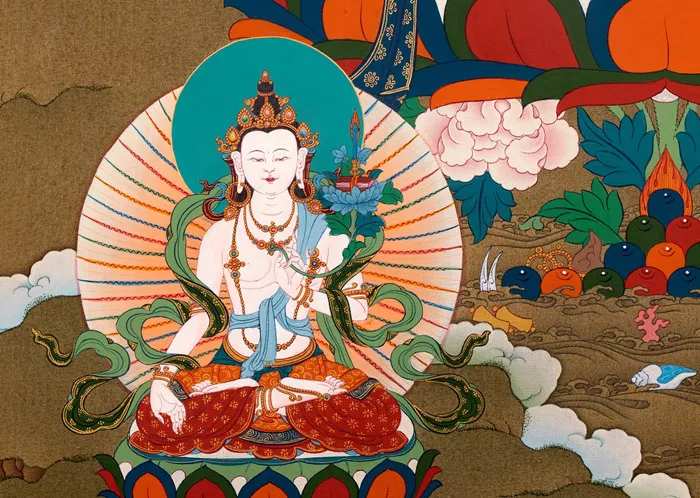Manjushri is one of the most important bodhisattvas in Buddhism. He is known as the embodiment of wisdom. In Buddhist teachings, Manjushri represents clear insight and deep understanding of the truth. Many Buddhist monks and practitioners look up to Manjushri as a guide to develop their wisdom on the path to enlightenment.
Who is Manjushri?
Manjushri, whose name means “Gentle Glory,” is a bodhisattva—a being who seeks enlightenment not only for themselves but also for all sentient beings. Unlike Buddhas, bodhisattvas delay their own final awakening to help others reach liberation. Manjushri is especially linked to wisdom, knowledge, and eloquence.
Manjushri in Buddhist Scriptures
Manjushri appears in many Buddhist texts, including the Prajnaparamita Sutras, where wisdom is emphasized as the path to enlightenment. He is often described holding a flaming sword in his right hand. This sword cuts through ignorance and delusion, which are the roots of suffering. In his left hand, he usually holds a lotus flower that supports a book—the Prajnaparamita Sutra—symbolizing the perfection of wisdom.
The Symbolism of Manjushri
Every part of Manjushri’s image carries deep meaning. His sword represents the sharpness of wisdom, which cuts through false views and illusions. The book on the lotus represents the highest teachings of the Buddha, especially about emptiness and insight.
Appearance and Iconography
Manjushri is often depicted as a youthful figure, symbolizing the fresh and lively nature of wisdom. His calm and gentle face shows the peace that comes from true understanding. Sometimes he is shown riding a lion, symbolizing fearlessness and the powerful voice of wisdom that can tame even the wildest mind.
Manjushri’s Role in Buddhist Practice
Many Buddhist monks and followers meditate on Manjushri to develop wisdom in their own lives. His practice is believed to help remove confusion and to increase clarity of mind. Manjushri is especially important for those who seek to deepen their understanding of Buddhist teachings.
Manjushri Mantra
The Manjushri mantra is a powerful chant used to invoke his blessings. It is often recited to gain sharpness of mind and improve learning. The most common mantra is:
“Om Ah Ra Pa Tsa Na Dhih”
This mantra is believed to awaken wisdom and to protect from ignorance.
Manjushri in Different Buddhist Traditions
Manjushri is revered across many Buddhist traditions, including Tibetan Buddhism, Mahayana, and Zen. In Tibetan Buddhism, he is often one of the main meditational deities. Tibetan monks may wear special robes and follow a buddhist monk lifestyle dedicated to cultivating wisdom through Manjushri practice.
Why is Manjushri Important?
Wisdom is considered one of the highest qualities a Buddhist can develop. Without wisdom, even good actions can become misguided. Manjushri teaches that true wisdom is not just intellectual knowledge but a deep insight into the nature of reality.
The Path to Enlightenment
According to Buddhist teachings, wisdom is the key to ending suffering. Manjushri’s role is to help practitioners see beyond surface appearances and understand the emptiness of all phenomena. This understanding leads to compassion and freedom from attachment.
Manjushri and Buddhist Monks
Many buddhist monks regard Manjushri as their spiritual guide in learning and teaching. The study of Buddhist scriptures, chanting of mantras, and meditation on Manjushri’s qualities are part of their daily routine. The focus on wisdom is central to the monk lifestyle, which values simplicity, discipline, and insight.
Manjushri’s Influence on Buddhist Education
Monks often invoke Manjushri before studying texts or giving teachings. This shows the deep connection between Manjushri and the intellectual and spiritual growth of Buddhist communities. His presence reminds monks and lay followers alike to approach learning with humility and dedication.
Practical Lessons from Manjushri
Manjushri’s teachings encourage us to develop several key qualities:
- Clarity of Mind: Learning to see things as they really are without distortion.
- Compassion: Wisdom and kindness go hand in hand; true wisdom leads to caring for others.
- Fearlessness: Facing challenges boldly with the help of insight.
- Continuous Learning: Wisdom is a lifelong journey; we should always seek to grow.
How to Practice Manjushri’s Wisdom Today
You don’t have to be a monk to connect with Manjushri’s wisdom. Here are some simple ways to bring his teachings into daily life:
1. Meditation on Wisdom
Set aside time each day to meditate on clarity and insight. Imagine Manjushri’s sword cutting through confusion in your mind.
2. Chant the Mantra
Recite “Om Ah Ra Pa Tsa Na Dhih” quietly or aloud to invite wisdom into your thoughts.
3. Study Buddhist Teachings
Read simple Buddhist texts or listen to talks that explain the nature of reality. Approach learning with curiosity, just like the monks who follow the buddhism monks outfit and lifestyle dedicated to study and practice.
4. Apply Wisdom in Daily Life
Try to see situations clearly without jumping to conclusions. Practice patience and understanding when dealing with others.
Manjushri’s Legacy and Influence
Manjushri’s influence goes beyond religious texts. He inspires art, culture, and even modern education in Buddhist countries. Temples and statues dedicated to Manjushri can be found throughout Asia, reminding people of the importance of wisdom.
Manjushri in Art and Culture
Artists often depict Manjushri holding his sword and book, surrounded by light. These images serve as symbols of knowledge overcoming darkness. Festivals and rituals in his honor celebrate the gift of wisdom.
Modern Relevance
In today’s fast-paced world, Manjushri’s message is very important. With so much information and distraction, wisdom helps us focus on what truly matters. Many people use Manjushri’s teachings to improve decision-making, learning, and communication.
Conclusion
Manjushri is much more than a figure in Buddhist stories. He is the living symbol of wisdom, guiding millions on the path to enlightenment. Whether you are a monk, a student, or someone seeking peace and understanding, Manjushri’s teachings offer timeless guidance. By cultivating wisdom, we can overcome ignorance, develop compassion, and live with greater clarity.

